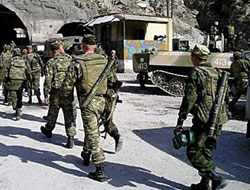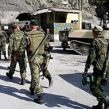
Harsh Measures only Strengthen the Insurgency in Dagestan
Publication: Eurasia Daily Monitor Volume: 8 Issue: 63
By:

On March 23, the village of Gubden in Dagestan was completely blockaded by Russian military, police and Federal Security Service (FSB) agents. After that, the servicemen began to search the homes of local residents. Sources in Gubden told the author of this piece that armed representatives of the power structures stormed into homes and subjected them to the total searches.
During this operation, 33 guns including seven pistols, more than 300 rounds of ammunition, seven tanker’s helmets with night vision equipment and two machine-gun belts were seized. Thirty-six people were arrested and brought to the local police station. According to the press service of the republican interior ministry, the police checked the documents and took the fingerprints of all the detainees and released them after interrogating all those detained (Kommersant, March 26).
Gubden is a large Dargin village in Karabudakhkent district of Dagestan, which is located south of Makhachkala and west of Izberbash, a resort city on the Caspian Sea. The village is considered the “capital” of the so called “Wahhabis” in Dagestan. In the North Caucasus, the term “Wahhabi” is used for adherents of a branch of Islam widespread in Saudi Arabia and several other countries.
However, supporters of this version of Islam in the North Caucasus consider this term a label with a negative connotation, and call themselves Salafis or fundamentalists. Most of North Caucasus armed insurgents are inclined toward fundamentalist Islam.
Gubden is the home village of Magomedali Vagabov, a Dagestani insurgent leader who was killed in August 2010. The current leader of the Dagestani insurgency, Ibragimkhalil Daudov, who became the insurgents’ leader following Vagabov’s death, also comes from this village. Daudov, who was in the Soviet army and participated in the invasion of Afghanistan, joined the Dagestani insurgency together with his three sons. His wife Zavzhat reportedly accidently blew herself up in Moscow on December 31 while preparing a suicide attack (EDM, February 16).
On February 14, a double suicide attack occurred in Gubden. Two servicemen were reportedly killed and 20 others injured in the attack. First, a female suicide bomber attacked a local police station early in the evening. Later that evening, a car loaded with explosives tried to approach a police checkpoint in the village and exploded during a shoot out between its driver, on one side, and policemen and Russian interior ministry servicemen, on the other (EDM, February 16).
The author of this article visited Gubden in December of last year and can attest to the fact that it is a very special place in Dagestan. There are no cigarettes or alcohol in village stores, and several years ago, drinkers were being detained and, to humiliate them, were put into cages and exposed in the streets. All the women in Gubden wear headscarves, many were yashmaks (veils), and nobody is surprised that some of its residents have two wives. Since there are no separate schools for boys and girls, many Gubden residents do not allow their daughters to go to school.
“This is not true that that only Wahhabis are living in the village,” Akhmed Akhmedov, the chairman of the Gubden municipality, told me. “The overwhelming majority of residents follow the version of Islam traditional for Dagestan. The difference between us and the so called Wahhabis is not so large. The only essential difference is that we think that nowadays there is no reason for jihad – that is, the fight against infidels – while the opinion of a majority of the Wahhabis is the opposite.”
“The police constantly summon Salafis for interrogations,” Mahomet Saidgadjiev, a 77-years old villager, told me, adding “There were also cases where policemen kidnapped people and then were killed. For example, my son was kidnapped in the center of the village; after that they placed a weapon in his hands and have declared him an insurgent. Fundamentalists are just compelled to become insurgents.”
Gulbariat Salamova, the widower of Magomedali Vagabov, the Dagestani insurgent leader mentioned above, shares these views. “My husband was studying in a Pakistani madrasah, and when he came back, he decided to teach Islam to his fellow villagers,” she said. “But the police and FSB were just torturing him with checks. They were permanently carrying out searches in our house. Eventually, my husband got tired of all of this, left the house for the woods and joined the insurgents.”
In the opinion of Gulnari Rustamova, a member of the board of the Mothers of Dagestan (this organization provides legal help for captured insurgents caught as well as for Salafis suspected in connection with the underground), the armed resistance would cease if Salafi were given a quota on the Spiritual Board of Muslims of Dagestan, if they were allowed to publish their newspapers and register their own organizations. According to Rustamova, in this case, even the most reluctant mujahideen would change the focus of their jihad and go to fight in Iraq or Afghanistan.
In the opinion of Zaur Gaziev, a Dagestani representative of the Memorial human rights organization, it is advantageous to the police when people leave for the woods. “In this case, the interior ministry receives additional subsidies and, on the other hand, it has excuses for their inefficient struggle with the usual criminals,” Gaziev said, adding “The attempt on the life of Bekmurzi Bekmurzaev, the head of the Ministry of National Affairs, Religion and External Communications, was quite expected: this man was trying to arrange a dialogue with moderate Salafis.” On September, 4, 2010, he and his two security guards were taken to a hospital with wounds after Bekmurzaev’s car was blown up. His driver died at the scene of the blast. Two of Bekmurzaev’s predecessors, Magomedsalikh Gusaev and Zagir Arukhov, were killed on August 27, 2003 and May 20, 2005, respectively (EDM, September 9, 2010).
It is hard to believe that the searches will dramatically change the situation in this enclave of Islamic radicals. Such actions were being regularly carried out in Gubden. However, the activity of the Islamic underground in this village is not decreasing, and the terrorist act in Gubden on February 14 convincingly proves this. It is noteworthy that, though authorities persistently carried out searches in the village itself, they had never carried out a large scale operation in the woods near Gubden, where the insurgent camps are still safe and untouched. Gubden is a sort of a symbol of Dagestani resistance to the Kremlin, and the situation there may serve as an indicator of the situation in Dagestan as a whole.
Nonetheless, the resistance of the Dagestani underground continues to intensify. Statistics for the past year reflect this as Dagestan accounts for nearly half of the deaths in the North Caucasus resulting from militant activity. In terms of the number of people killed, Dagestan is ahead of all the other North Caucasus republics: in 2010, 378 people were killed in Dagestan while 754 were killed in all of the North Caucasus. Note that in 2010, in Dagestan the number of law-enforcement and military personnel who died for the first time approached the number of insurgent deaths reported by official structures in Moscow. In previous years, on average, there were three insurgents killed for each official who died as a result of a militant attack. This ratio has continued to climb in spite of Moscow’s failing efforts to subdue the regional militant movement (Novye Izvestia January 20).




